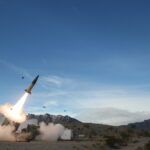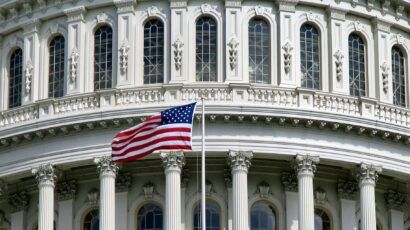Time for a nuclear pause agreement?
By Adam M. Scheinman | August 7, 2018

There can be no denying it: Nuclear arms control is in a rut. Regrettably, prospects for new agreements look unlikely to improve in the near future. But must nations wait passively for circumstances to improve, or worse yet, sit on their hands as conditions deteriorate? No—instead, nuclear-armed nations could pursue a “nuclear pause” agreement whereby they would commit, for a limited time, not to conduct nuclear tests or produce additional fissile material for weapons. Such an agreement would not meet the aims of the Comprehensive Nuclear Test Ban Treaty (CTBT), which has not yet entered into force, or of the Fissile Material Cutoff Treaty, which hasn’t been successfully negotiated. But the pause agreement would buy the world some time during a period of fraught international relations—and could set the stage for more meaningful arms control measures in the future.
Stabilizing the nuclear landscape. Slumps in nuclear arms control are hardly new, but the problems today run deep. For the first time since the 1962 Cuban Missile Crisis, no arms control agreement involving the nuclear-armed states is on the agenda, in negotiation, or under serious consideration. (The North Korea talks don’t count, as they concern only the de-proliferation of a single state). This lack of arms control momentum is striking: Between the 1963 Limited Test Ban Treaty and New START in 2010, one has to dig deep to identify pockets of time when new or follow-on agreements were absent from the agenda.
But absent they are. The deterioration of US-Russia relations after Moscow’s annexation of Crimea in 2014, not to mention Russian violations of the Intermediate-Range Nuclear Forces Treaty, have essentially gutted prospects for new bilateral deals. US-Chinese agreements remain a distant hope, given the significant disparity in the size of the US and Chinese arsenals. Elsewhere, India and Pakistan remain locked in a slow-moving nuclear arms race. North Korea, while now engaged with the United States on denuclearization, has the technical capacity to ramp up its nuclear weapon and ballistic missile activities quickly. And in the chaos that is the Middle East, an Iranian dash for a Bomb could spark a dangerous regional race for nuclear weapons. Such a state of affairs hardly inspires optimism!
Generally, where nuclear weapons and arms control are concerned, it is safer to bet on gloomy predictions than rosy ones. That attitude seems even more appropriate today, with the world’s strategic landscape in transition. During the Cold War era, and during the US unipolar period that followed, nuclear arms control survived and in fact thrived. But the world is clearly entering a new phase in geopolitics—one that will inevitably test the resilience of existing nuclear agreements and, even more so, the appeal of new ones. Can arms control accommodate China’s accelerating rise? Can it survive Russia’s determination to discredit the European security architecture, or to regain primacy in countries sitting along its sprawling borders? Can nuclear arms control solve the Indo-Pakistani nuclear puzzle—or prevent the emergence of future North Koreas, where illiberal leaders pursue nuclear weapons as a means for national survival or intimidation?
These are tough, challenging questions. Indeed, some may conclude that nuclear arms control should be shelved until political conditions change. But the relationship between arms control and international stability isn’t quite like that between the chicken and the egg, where one or the other must come first. Yes, arms control is easier when conditions allow nations to choose negotiations over arms racing, a choice that in turn can limit competition for strategic advantage. But at the same time, the habits, dialogue, transparency, and verification that accompany arms control can build up confidence, security, and the other ingredients necessary for international or regional stability. In this sense, arms control and security are mutually reinforcing—one contributes to the other.
So rather than succumb to fatalism, the nuclear powers could now consider a nuclear pause arrangement, designed to stabilize the nuclear landscape and create space for new agreements as conditions permit. The pause agreement would have two central elements: first, a commitment not to test nuclear weapons and, second, a commitment not to produce fissile material for nuclear weapons. The agreement would run for a period of five or 10 years—after which it could be extended or discarded. Participants would presumably be the nuclear weapon states recognized under the Nuclear Non-Proliferation Treaty (NPT)—the United States, Russia, the United Kingdom, France, and China—plus India, Pakistan, North Korea, and potentially Israel. Verification could be accomplished through national technical means, supplemented by the International Monitoring System that is part of the CTBT, and the International Atomic Energy Agency, which already safeguards facilities for fissile material production in states around the world.
Circumventing obstacles. Embedded in the pause idea are two grim realities for arms controllers—that, in the near term, the CTBT will not gain the ratifications needed to enter into force (including US ratification); and that negotiations on a global Fissile Material Cutoff Treaty will remain an aspiration, stuck in place and time at the Geneva Conference on Disarmament.
The test ban and cutoff treaties have long roots in arms control, and share a spotty history. The test ban treaty in particular is closely linked to the NPT’s disarmament obligation and has been among the practical, achievable, and realistic arms control steps endorsed by US administrations, off and on, since Eisenhower was president. The current US administration indicates it will not support ratification of the test ban treaty, presumably due to concerns that the treaty is not perfectly verifiable or that the United States may one day need to test a nuclear weapon for whatever reason. Absent US ratification, it seems unlikely that China, India, Pakistan, North Korea, and the few other nations whose accession is required for the treaty’s entry into force will indeed accede. The US administration is more open to negotiation of a cutoff treaty, but the problem there is Pakistan—which, throughout the Obama years, stymied the start of cutoff negotiations for the stated reason that a treaty would permanently lock in India’s nuclear production advantages. In truth, it seems more likely that Pakistan has some notion of what it needs for its stockpile of nuclear weapons material and has simply not reached that level. Yet unclassified estimates put Pakistan’s nuclear arsenal on par with India’s—indeed, Islamabad’s arsenal may eclipse New Delhi’s soon, if it hasn’t already.
Global agreements such as the test ban and cutoff treaties have traditionally been seen as a way around obstacles that have prevented the negotiation of regional arms control agreements. These obstacles can be thought of as circular linkages—Pakistan is focused on India; India on China and to a degree Pakistan; China on the United States and to a degree Russia; Russia on the United States and to a degree China; and so on. A nuclear pause agreement, by adopting a multilateral structure that brought in all key participants, might circumvent these obstacles. Still, in the spirit of not making the best the enemy of the good, it would in important respects stop short of a permanent and global prohibition on nuclear testing and fissile material production.
Here’s what a nuclear pause agreement would not do:
- It would not substitute for the CTBT or the Fissile Material Cutoff Treaty. States that have ratified the CTBT—as Russia, the United Kingdom, and France did in prior years—have already committed not to conduct nuclear tests. The pause agreement would impose a parallel commitment by the other participants for a limited period of time. Meanwhile, the CTBT’s International Monitoring System is about 90 percent operational, and it’s working: It has detected each of the six North Korean nuclear tests. Indeed, the pause agreement could serve as motivation to finalize the installation of all remaining monitoring stations, and ultimately improve prospects that all 44 states whose ratification is required for the CTBT to enter into force will ratify it.
The commitment not to produce military fissile material—unlike the one not to conduct nuclear tests—lacks a treaty analogue. The NPT does not require that nuclear activity in the five nuclear weapon states be verified by the International Atomic Energy Agency—and India, a non-NPT state, has allowed only partial agency monitoring of its plutonium reprocessing. (The United Kingdom and France allow agency verification of commercial reprocessing and/or enrichment under a separate regional treaty.) The pause agreement should extend agency verification to all current and planned facilities, whether civil or military, for plutonium reprocessing and uranium enrichment in the participating states. The costs would be significant, and would presumably be covered by the host state or through some special agency fund. Challenge-type inspections should be set aside, however, as they would introduce huge, show-stopping complications regarding inspection modalities, access to military facilities, and so forth. This issue would be covered when the participating states were ready to join the CTBT and an eventual global cutoff treaty.
- The pause agreement would not extend for an indefinite time. A model in this regard is the 1972 Strategic Arms Limitation Treaty Interim Agreement, which froze US and Russian ballistic missiles for a five-year period. Limiting the agreement’s duration would address the reality that a pause would pose a more difficult problem for some states than for others. The United States, for example, has not tested a nuclear weapon or produced new fissile material for weapons in more than 20 years. But for India and Pakistan, which have not tested nuclear weapons since 1998 but are accumulating military stocks of fissile materials every day, the impact of a pause deal would be far greater. China, meanwhile, has not tested nuclear weapons since 1996, when talks toward the test ban treaty concluded, but Beijing typically spurns joint statements or NPT documents that endorse a moratorium on fissile material production.
- The pause agreement would not substitute for North Korean denuclearization talks. That is, North Korea would not be able to pick and choose which agreements it acceded to. A pause agreement’s no-testing and no-production pledges, especially if they were subject to verification measures, would certainly be relevant to the North Korean case—and in this sense, Pyongyang’s participation in a pause agreement could check one of many boxes necessary for assuring the elimination of North Korea’s nuclear weapons potential, as well as its return to the NPT and to comprehensive IAEA safeguards.
- Nor would a pause agreement substitute for Middle East dialogue on a regional zone free of weapons of mass destruction. Momentum toward such a dialogue waxed and waned over recent years, but ultimately collapsed due to disagreements between Israel and the Arab states. Given the sui generis character of the region, and the challenges for mutual arms control that the region presents, a pause agreement that included Israel or even Iran would create optics problems—and would elicit charges of legitimizing one or the other as a nuclear power. A better option, and perhaps a more practicable one, would be for Israel, Iran, and Egypt to come into the test ban treaty together. Such a step could itself serve as motivation to establish a broader regional arms control dialogue.
Finally, though a pause agreement could be complemented by additional commitments from nuclear states, it need not include them as specific commitments. Such an approach would help avoid endless debates about how many ornaments to hang on the tree, a favored pastime of multilateral negotiations. The most obvious example of an additional commitment would be a US-Russian decision to extend New START through 2026, as allowed under that agreement. An extension would be significant in its own right and, though it would clearly add weight to the pause agreement, should be independent of it.
On the outer rim. It’s fair to debate whether a pause agreement should have legal effect or take the form of a non-binding political statement. An agreement with legal effect would have greater force, though it would also introduce additional uncertainties, given domestic politics in Washington and perhaps other capitals. A political agreement implies a softer, more easily reversed commitment—though, in either case, monitoring of plants for fissile material production would be accomplished under a legal agreement between individual states and the International Atomic Energy Agency. On balance, higher barriers to new testing or new fissile material production for weapons are better than lower barriers, so the legal route should at least be tried.
A nuclear pause agreement would be imperfect, but is potentially achievable—the best measure of any agreement’s utility. Unlike the recently minted nuclear weapon prohibition treaty, the pause agreement would enlist states that actually possess nuclear weapons and would serve as a bridge toward pursuit of additional actions when conditions allow. It would brighten prospects for eventual attainment of global test ban and cutoff treaties. It would, for the first time, hold in place the nuclear arms race in South Asia and the nuclear build-ups in China and North Korea. It would contribute to nuclear security goals by monitoring the fissile materials of most interest to terrorists. And it would perhaps create opportunities to reinvigorate US strategic dialogues with Russia and China.
A pause agreement is a limited measure: limited in scope, duration, and number of participants. It is not hugely ambitious, though bringing certain states on board (namely India and Pakistan) would require considerable political suasion and packaging of incentives or disincentives. That said, putting aside a five-year extension of New START, a pause agreement may well sit on the outer rim of what is achievable in nuclear arms control for now. That alone is reason to give the concept some thought.
The views expressed in this article are those of the author and are not an official policy or position of the National Defense University, the Defense Department, or the US government.
Together, we make the world safer.
The Bulletin elevates expert voices above the noise. But as an independent nonprofit organization, our operations depend on the support of readers like you. Help us continue to deliver quality journalism that holds leaders accountable. Your support of our work at any level is important. In return, we promise our coverage will be understandable, influential, vigilant, solution-oriented, and fair-minded. Together we can make a difference.
Keywords: China, India, Iran, Israel, Pakistan, Russia, United States, nuclear disarmament
Topics: Nuclear Risk, Nuclear Weapons
















Dream on > https://www.prageru.com/videos/iran-and-bomb